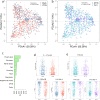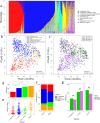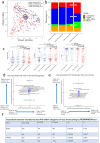Race, the Vaginal Microbiome, and Spontaneous Preterm Birth
- PMID: 35582911
- PMCID: PMC9238383
- DOI: 10.1128/msystems.00017-22
Race, the Vaginal Microbiome, and Spontaneous Preterm Birth
Abstract
Previous studies have investigated the associations between the vaginal microbiome and preterm birth, with the aim of determining whether differences in community patterns meaningfully alter risk and could therefore be the target of intervention. We report on vaginal microbial analysis of a nested case-control subset of the Pregnancy, Infection, and Nutrition (PIN) Study, including 464 White women (375 term birth and 89 spontaneous preterm birth, sPTB) and 360 Black women (276 term birth and 84 sPTB). We found that the microbiome of Black women has higher alpha-diversity, higher abundance of Lactobacillus iners, and lower abundance of Lactobacillus crispatus. However, among women who douche, there were no significant differences in microbiome by race. The sPTB-associated microbiome exhibited a lower abundance of L. crispatus, while alpha diversity and L. iners were not significantly associated with sPTB. For each order of magnitude increase in the normalized relative abundance of L. crispatus, multivariable adjusted odds of sPTB decreased by approximately 20% (odds ratio, 0.81; 95% confidence interval, 0.70, 0.94). When we considered the impact of douching, associations between the microbiome and sPTB were limited to women who do not douche. We also observed strong intercorrelations between a range of maternal factors, including poverty, education, marital status, age, douching, and race, with microbiome effect sizes in the range of 1.8 to 5.2% in univariate models. Therefore, race may simply be a proxy for other socially driven factors that differentiate microbiome community structures. Future work will continue to refine reliable microbial biomarkers for preterm birth across diverse cohorts. IMPORTANCE Approximately 10% of all pregnancies in the United States end in preterm birth, and over 14% of pregnancies end in preterm birth among Black women. Knowledge on the associations between vaginal microbiome and preterm birth is important for understanding the potential cause and assessing risk of preterm birth. Our study is one of the largest studies performed to date to investigate the associations between vaginal microbiome and spontaneous preterm birth (sPTB), with stratified design for Black and White women. We found that the vaginal microbiome was different between Black and White women. The vaginal microbiome was associated with sPTB, and a lower abundance of L. crispatus increased the risk of sPTB independent of racial differences in microbial community structures. Furthermore, we also found that vaginal douching obscured the associations between vaginal microbiome, race, and preterm birth, suggesting that vaginal douching is an important factor to consider in future studies.
Keywords: douching; preterm birth; race; vaginal microbiome.
Conflict of interest statement
The authors declare no conflict of interest.
Figures



References
-
- Martin JA, Hamilton BE, Osterman MJ, Driscoll AK. 2019. Births: final data for 2018. Natl Vital Stat Rep 68:1–47. - PubMed
Publication types
MeSH terms
Grants and funding
LinkOut - more resources
Full Text Sources

